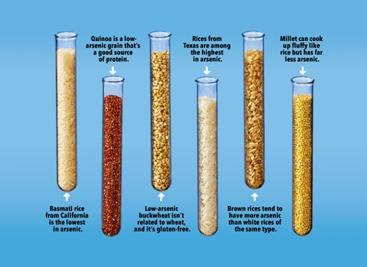The recent popularity of gluten-free diets has contributed to an increase in consumption of rice and rice-based products. Moderation in rice consumption has been advised, because rice is a major dietary source of the trace element arsenic and long-term exposure to arsenic is associated with higher rates of certain cancers (skin, bladder, lung) and heart disease. In 2015, Consumer Reports published guidelines on rice consumption that recommended adults limit their rice consumption to 2.3 cups of cooked Basmati rice or 1 cup of other types of cooked rice per week to minimize exposure to arsenic. Weekly serving guidelines for other rice products for adults and children were also published in Consumer Reports. For those interested in avoiding gluten, gluten-free grains (including amaranth, quinoa, buckwheat, millet, and polenta) have much lower average levels of arsenic. Bulgur, barley, and faro, which do contain gluten, also have very little arsenic.
Arsenic absorption and accumulation in the body is also affected by intake of other nutrients including vitamin D and trace minerals like selenium and zinc. High doses of vitamin D has been reported to increase absorption of arsenic when the dietary intake of selenium and/or zinc is low. So in addition to moderating intake of food sources of arsenic, like rice, it would seem useful to limit intake of vitamin D to well below the Tolerable Upper Limit of 4,000 IU/day and to consume at least the Daily Value (DV) of selenium (70 mcg/d) and zinc (15 mg/d). Protein foods, including meat, poultry, seafood, and eggs are good sources of both selenium and zinc. Milk products, legumes, and whole grains provide less of these nutrients. To insure an adequate intake of both selenium and zinc, it’s a good idea to consume at least 5 to 7 servings of protein foods daily. A serving is 1 ounce of cooked meat, fish, poultry; ¼ cup canned fish; 1 egg; or ¼ cup cooked legumes. For those avoiding animal foods, Brazil nuts are high in selenium, with each Brazil nut providing close to the Daily Value (DV) of 70 mcg.
So with regard to minimizing dietary exposure to arsenic and limiting its accumulation in the body, dietary moderation and variety is the best plan. For a gluten-free main dish, enjoy Tamale Pie with Polenta, Turkey, Tomatillo Salsa. It makes a great potluck dish — easy to prepare, and you can assemble the recipe ahead of time and heat up right before your guests arrive. The beans make this recipe high in fiber, especially soluble fiber, which supports a healthy gut biome.
